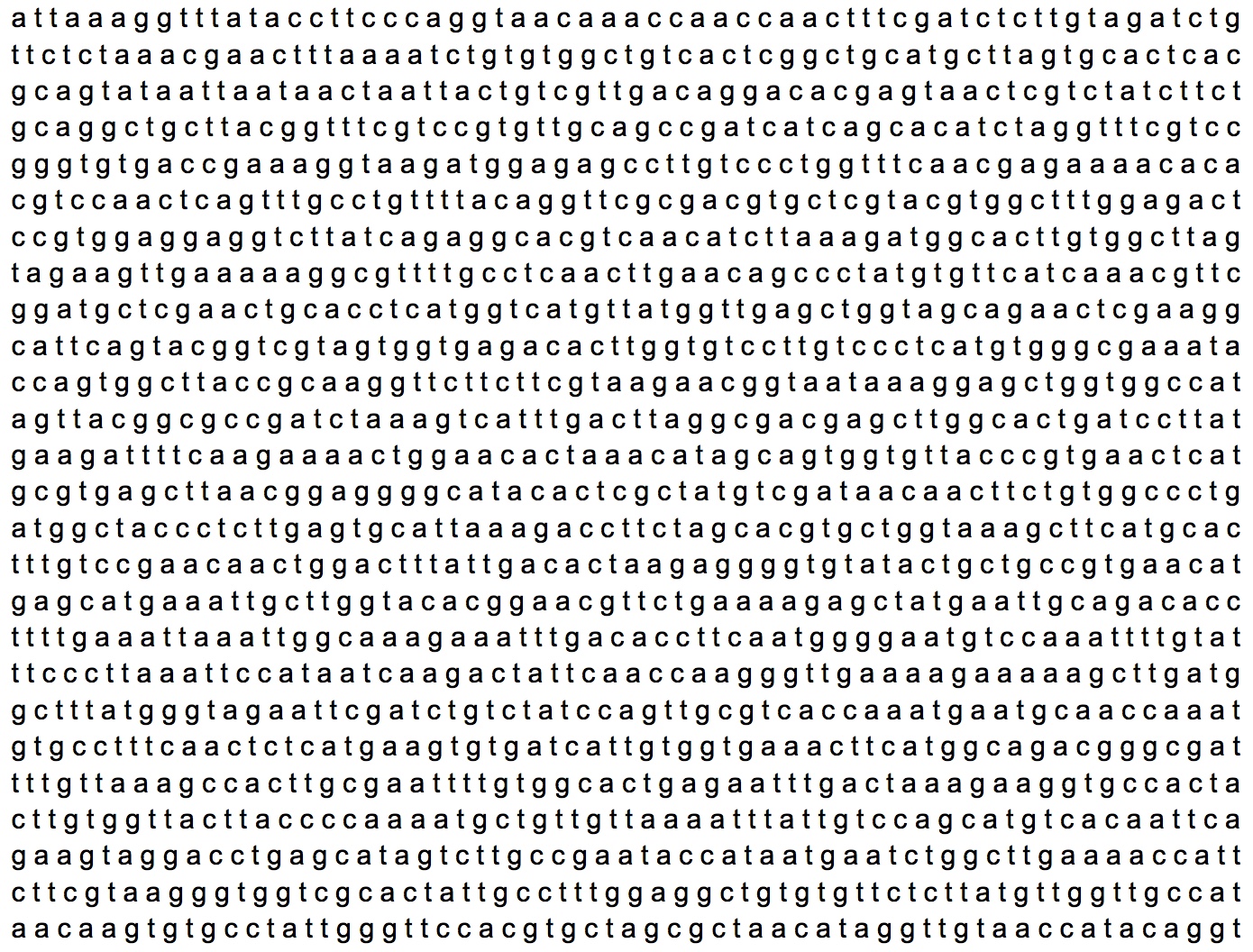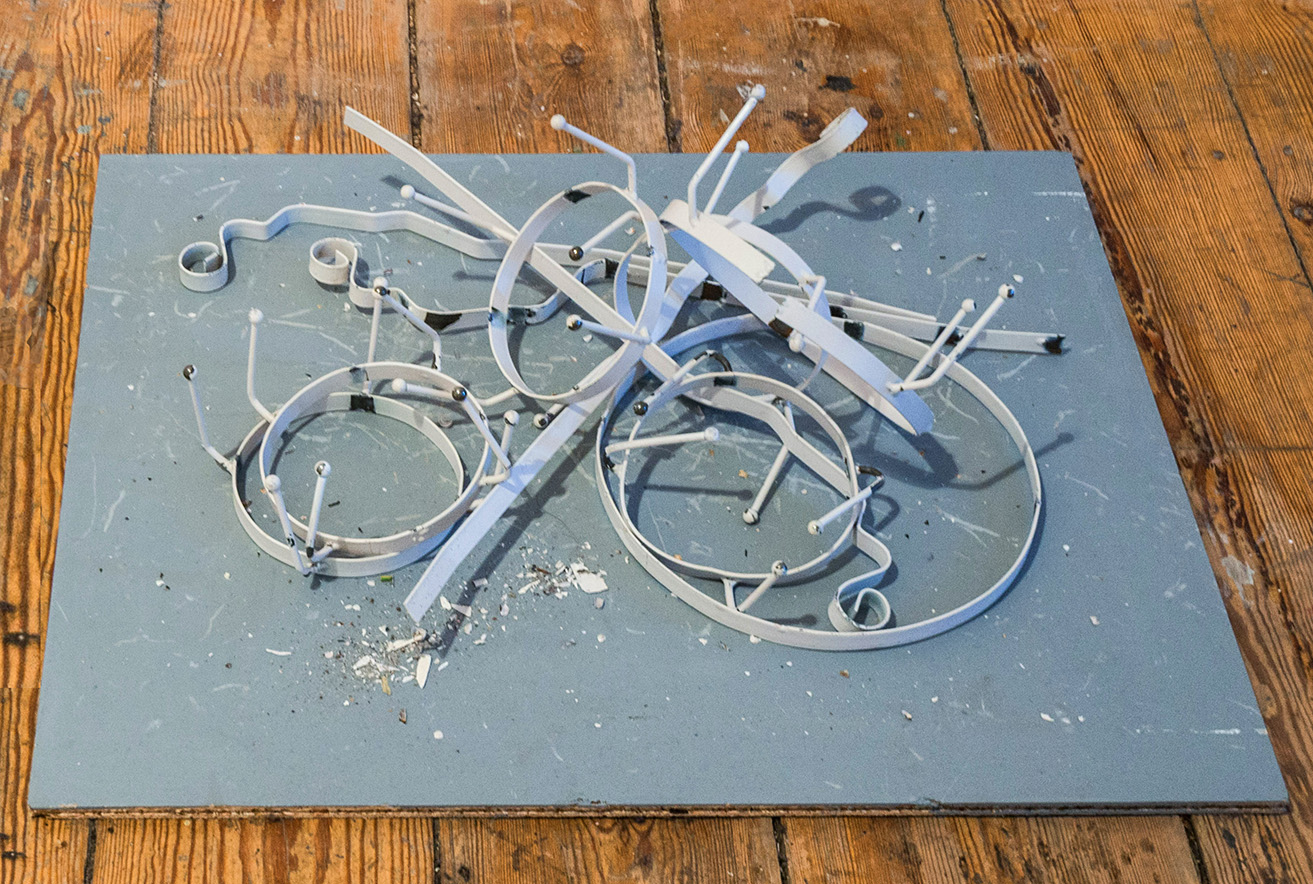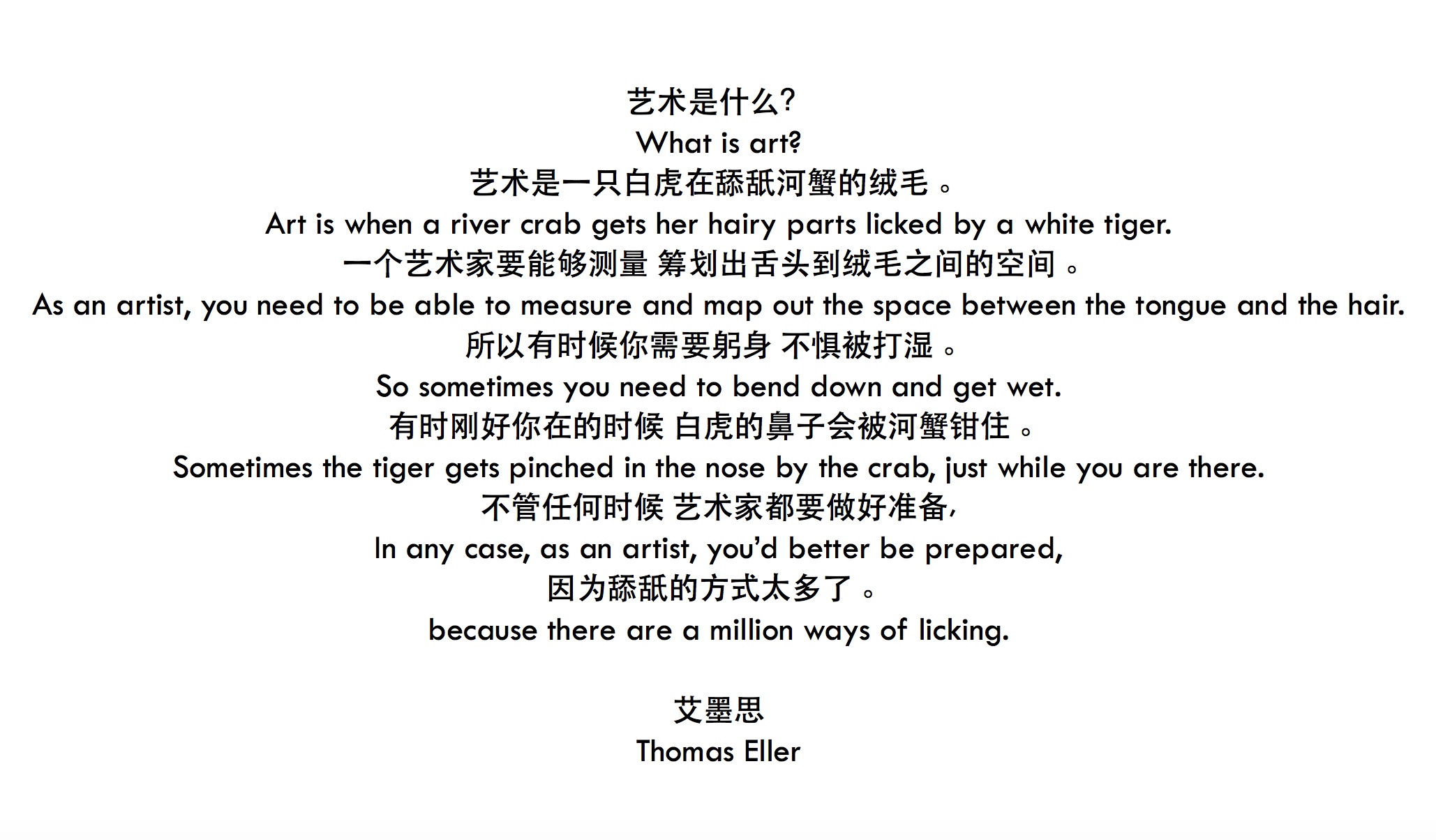 |
THOMAS ELLER
(b. 1964 in Coburg, Germany. Lives and works in Berlin and Mursbach, Germany.)
Thomas Eller is an artist, curator, professor, and publisher. Eller started his studies in Fine Arts at the Hochschule der Künste of Berlin. After his forced dismissal, he went on to graduate in Sciences of Religion, Philosophy and Art History from the Freie Universität, Berlin (1989). Eller started his career in Berlin. From 1990 until today he has been exhibiting extensively in galleries and museums in Europe, Asia and the Americas. His international awards include: the Karl-Schmidt-Rottluff Prize (1996), the Villa-Romana Prize (Florence, 2000), the Art Omi International Art Center (New York, 2002) and the Käthe-Kollwitz-Prize from the Akademie der Künste (Berlin, 2006).
From 1995 until 2004 Eller was living in New York. After returning to Berlin, he founded the German edition of Artnet Magazine, artnet.de, where he served as editior-in-chief (2004-2008) and was appointed executive director of the German branch of artnet AG (2005-2008). In 2008-2009, Eller served as Artistic Director of the Temporäre Kunsthalle, Berlin. He has been a member of various institutions, including the Association of International Art Critics (AICA), a Member of the Board for Creative Industries at the Chamber of Commerce in Berlin, and on the Steering Committee for Creative Industries in the Berlin Senate. Since 2013 he has been president of RanDian magazine. In 2014, heralding his move to Beijing, China (2014-2020), Eller co-curated the exhibition “The 8 of paths” with 23 Beijing-based artists in Berlin. Since moving to Beijing in 2014, Eller has taught at the Chinese National Art Academy, Beijing (2019), Tianjin Academy of Fine Arts (TAFA) (2017), Tsinghua University and Sotheby’s Institute (2016 – 2017), and was associate researcher at Tsinghua University (2019-2020). He was a correspondent for Frankfurter Allgemeine Zeitung in Beijing (2016-2017). In 2018 he founded Gallery Weekend Beijing. And in 2018-2021, Thomas Eller was the Founding Artistic Director of “Taoxichuan China Arts & Sciences” – a major new art district to feature international artist residencies, a contemporary art museum and a biennial, in Jingdezhen, the porcelain capital of the world in the Jiangxi province. In 2022-23, Eller is co-curator of the 7th Guangzhou Triennial at the Guangdong Museum of Art, Guangzhou, China (2023).
In 2020 Thomas Eller returned to Germany and started developing an old water mill in Mürsbach, Franconia, as a center for international art, fuelled by green energy. THEgallery is an exhibition and artist residency space with a focus on ecology, sustainability, and migration.
As an artist, recent solo exhibitions include: “Kill Einstein“, Diskurs, Berlin (2016); “Ritan Park“, Studio Heiqiao, Beijing, China (2016); “THE White Male Complex, No.3 (49 portraits)“, SAVVY contemporary, Berlin (2014); “THE White Male Complex, No.2 (Thomas KELVIN Eller)“, Schau Fenster, Berlin (2013); “Perfect Suspense“, Hania Bailly Contemporary, Geneva, Switzerland (2012); “THE ego show – a group exhibition”, Autocenter Berlin (2010); “THE”, artnewsprojects, Berlin (2009); “THE incident”, The Columns Gallery, Seoul, Korea (2008); “THE white male (Käthe-Kollwitz-Preis)”, Akademie der Künste, Berlin (2006). And selected Group Shows include: “Points of Resistance V: You Know That You Are Human”, MOMENTUM @ Zionskirche, Berlin (2022-23); COVIDecameron: 19 Artists from the MOMENTUM Collection (2020); “How Beautiful You Are!“, KINDL – Centre for Contemporary Art, Berlin (2020); “Sculpture Project Ping Yao“, Ping Yao, China (2019); “Transcending Dimension, Sculpting Space“, Pingshan, Shenzhen, China (2019); “Black Hole Sun. The Monochrome in Art“, Houston Art, Texas, USA (2019); Dong Guan Sculpture and Installation Art Festival“, Dong Guan, China (2018); “Kollwitz neu denken“, Käthe-Kollwitz-Museum, Cologne, Germany (2017); “1st DaoJiao Art Festival“, Dong Guan, China (2016); “1884-1915. An Artistic Position“, National Gallery of Namibia, Namibia (2016); “I see. International Video Art Festival“, New York, USA (Anthology Film Archives), Oslo, Norway (RAM Galleri); “Chercher le garçon“, Musée d’art contemporain du Val-de-Marne, Paris, France (2015); “I see. International Video Art Festival“, Chongqing, China (LP Art Space), Shenzhen, China (OCT), Guangzhou, China (Times Art Museum), Beijing, China (Institute for Provocation), Berlin (MOMENTUM); “Squatting“, Nassauischer Kunstverein Wiesbaden, Germany (2014); “The Other Where.” Open Space, Vienna Austria, Video Biennale, Buenos Aires Aregentina, Eve Sussman group, New York USA (2014); “Pandamonium: Media Art from Shanghai“, MOMENTUM, Berlin (2014); curator of ‘The 8 of Paths: Art from Beijing”, Uferhallen, Berlin (2014); “Lost“, BOCS, Catania, Siciliy, Italy (2014); “The Name, The Nose“, Museo Laboratorio, Citta’ Sant’Angelo, Italy (2013); “Money, Money, Money“, Kunstforum Halle, Germany (2013); “Experience 03: Truth“, El Segundo Museo, Los Angeles, USA (2013); “Zeitgenössische Fotografie und Videokunst“, Kunsthalle Bremen, Germany (2013); “The Legend of the Shelves”, Autocenter Berlin (2013); and many more exhibhitions dating back to 1991.
THE White Male Complex #14
2022, Video, 20 min 33 sec
The work is a reading of various parts of the book “Das Paradies der Liebe” (the paradise of love) by Johann Baptist Schad who was born 1758 in my village, Mürsbach. He became a Benedictine monk, defected after anonymously writing a scathing report about the bigotry of the Catholic church at the time. He converted to Protestantism and became a professor of philosophy in Jena under the mentorship of Johann Gottlieb Fichte.
Later he was recommended by Goethe as philosophy professor in Charkiw, where he lived and worked for 16 years. The text splinters read by me are witness to a rebellious mind that challenged social and cultural injustices inflicted on humanity by orthodoxy, greed, dumbness and cruelty.
– Thomas Eller
THE virus – SELBST (C0vid-20-Recovered)
2020, Video, 5 min 24 sec
Thomas Eller’s THE virus – SELBST (C0vid-20-Recovered) was made in the midst of the Corona pandemic, while the artist was in lockdown in China. As so much of Eller’s work, it is a self-portrait, yet at the same time, also an intimate portrait of COVID-19; replicating in its form and content the biological basis of the virus.
Eller projects himself into the frame in a visually and aurally layered palimpsest. The artist re-duplicates himself, again and again, with each of his copies reciting the complete genetic code of one of the first strains of the SARS-CoV2 virus identified in Wuhan, where the COVID-19 outbreak began. But the copies are not perfect. The duplicates vary. Eller makes mistakes in the code, scrambling the RNA sequence here, dropping a nucleotide there….
More copies of genetic code, more small mistakes here and there. Thomas Eller has translated into visual language an approximation of how the virus replicates itself, spreading its genetic information through multiplication, and through mistakes from copy to copy, mutating to create new strains.
Ceaselessly copying itself, undergoing mutations along the way, the virus has generated more than two hundred different strains, so far, from this original genetic sequence. Scientists have not yet made sense of the variations between the strains. They are as random as the mistakes the artist invariably makes while reeling off dense lines of genetic code.
Amongst the duplicates on the screen, a digitally altered copy of the artist enters the frame; an Eller in pixels, with a computer’s robotic voice reciting the sequence of nucleotides. Technology is racing to overtake the virus, but when will it catch up? We are still waiting, and hoping, for a viable vaccine, for a treatment, for a cure. Until then, we hide from the virus, and from each other. We distance, socially, and wait for a scientific breakthrough, hoping that science will win this race against nature. We should be so lucky if the virus simply stops, as Eller does, and goes away.
– Rachel Rits-Volloch

THE White Male Complex, #5 (Lost)
2014, Video, 11 min 25 sec
Shot on the beach of Catania on the Italian island of Sicily in 2014, THE white male complex, #5 (lost) uncannily prefigures the tragic shipwreck of 2015 which killed 700 African migrants on the same coastline, and alludes to the nearby island of Lampedusa, infamous for its migrant traffic and for the tragic shipwreck which killed 366 of the 518 African migrants packed onto an overcrowded fishing boat in 2013. With the all too familiar promiscuity of news cycles in our turbo-charged information age, these tragedies occupied the media for some days or weeks, only to move on to more pressing concerns. But while the media may have lost interest, the underlying issues behind these tragedies and many others like them will persist as long as people anywhere on this globe nurture hopes of a better life and follow their instincts to flee hardships of all kinds. Into this gap between the global media’s disinterest and the persistent need to tell the story of people in such desperate situations, enters the space for art.
A man wearing the ubiquitous attire of innumerable professions – black suit and tie, white shirt, black shoes – is incongruously floating in the ocean. Floating or drowning? This is what we inevitably come to ask ourselves as the shot lurches from above to below the water and back. This man perpetually struggling in the sea is the artist himself. In this video, Thomas Eller lives the plight of so many who wash up on such shores.
Eternally looping at the cusp of life and death, this work leaves the viewer feeling oddly complicit in one man’s surreal struggle. Yet while one white man submerged in a suit comes across as surreal, the countless migrants braving a similar plight are the reality we live in. Thomas Eller, in his own visual language tackles the watery deaths of migrant workers as a sadly universal suffering, devoid of markers of place or time. This could be any sea, any beach, any tragedy. And in the timeless metaphor of treading water, this work equally signifies our persistent inability to move forward in finding a solution to the myriad issues driving people around the globe to risk their life in the pursuit of a better one.
Taken out of context and read solely through the metaphor of keeping one’s head above water, THE white male complex, #5 (lost) becomes a timeless work, equally applicable to the struggles of the human condition. Professionally, personally, who amongst us has not at some point in their lives felt as if they were drowning. Almost, but never quite, succumbing to the pressures, expectations, and fears pulling him under, Thomas Eller translates an experience universal to the human condition into a visual language which can be read as at once hopeful, hopeless, and immutable.
– Rachel Rits-Volloch
THE White Male Complex (endgame)
2014, Installation: Unknown metal, plywood and paint

THE White Male Complex (endgames) is the working title of a series of art works, performances and talks by artist, curator Thomas Eller, in which he navigates the cultural plateau we have all entered in the West. With little chance for change we are collectively engaged in re-spelling the vocabulary developed by artists generations in the past 40 years—a conservative approach to progress resulting in endless artistic endgames. This artifact in the MOMENTUM Collection results from a performance by Thomas Eller (on 25 May 2014 for the ‘Works On Paper II’ Performance series, a part of the exhibition ‘PANDAMONIUM—Media Art form Shanghai’).
Thomas Eller – On Art

Watch here the Spotlight interview with Thomas Eller


 Back to Index
Back to Index